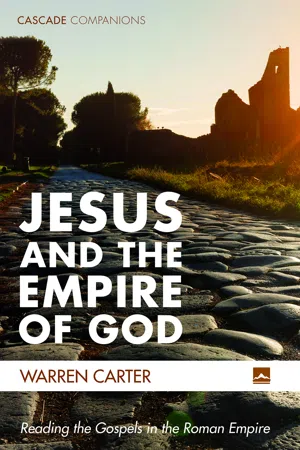![]()
1
Gospel Texts
Are Not Islands
Cultural Intertextuality
The New Testament and the Roman Empire
The New Testament Gospels come into existence in a world under the rule of the Roman Empire. Though written in the last decades of the first century, the Gospels set their narratives in the beginning of the first century in Galilee-Judea in the rule of Herod and thereafter in the rule of the Emperor Tiberius who died in the year 37 CE and in the governorship of Pontius Pilate (26–37 CE):
In the fifteenth year of the reign of Emperor Tiberius, when Pontius Pilate was governor of Judea, and Herod was ruler of Galilee, and his brother Philip ruler of the region of Ituraea and Trachonitis, and Lysanias ruler of Abilene, during the high priesthood of Annas and Caiaphas, the word of God came to John son of Zechariah in the wilderness. (Luke 3:1–2)
The main character, Jesus, was born when the Rome-appointed client king Herod was king of Judea.
In the time of King Herod, after Jesus was born in Bethlehem of Judea, wise men from the East came to Jerusalem, asking, “Where is the child who has been born king of the Jews?” (Matt 2:1–2)
The designation “king of the Jews” puts Jesus off-side with Roman rule since only Rome-appointed figures could legitimately claim to be kings. Kingly figures not sanctioned by Rome were executed. Jesus conducts most of his activity in Rome-ruled Galilee. Adding to tense interaction with Roman power is his central proclamation that “the kingdom/empire of God has come near” (Mark 1:15). The language of “kingdom/empire” both replicates the language of the Roman Empire as well as contests it by asserting another empire in its midst. Jesus moves to Jerusalem, where the Roman governor Pilate executes him by crucifixion.
These are just a few of the obvious points of contact between the Gospels and the Roman Empire. Many more will emerge in the following chapters as we identify further interactions—at times imitative, at times conflictual, at times reinscribing—between the Gospels and Rome’s empire. The empire does not disappear from the Gospels just because an emperor or governor or soldier or tax is not mentioned. Rome-sanctioned, Jerusalem-based local leaders, pervasive sickness, food insecurity, occupied territory, language of sovereignty, fantasies of revenge, and visions of a new and just world all interact with Roman imperial structures and practices.
Cultural Intertextuality
This approach is called cultural intertextuality.1 It represents an approach that places texts into relationship with other texts to create meaning. It does not claim that one text was the direct source for another, but it does recognize that texts from quite different communities and traditions participate in various ways in common cultural contexts and interact with various other texts.
We can make several observations about this network or cultural intertextuality.
First to be noted is that I, as the author of this book, am responsible for creating this intertextuality or network between Gospel texts and Roman imperial texts. I have selected these texts and placed them alongside each other thereby creating the opportunity for us to make meaning in the intersections among them. We have no way of knowing whether the authors of these texts ever intended them to be placed together. But as we know from social media, authors of spoken comments, emails, texts, and tweets do not control the reception of their messages. Cultural intertextuality is reader-centric, not author-centric.2
Second, I restrict my selection of texts to a particular time period and region, namely the first and early second centuries of the Common Era and the Roman Empire. I have not identified all the texts from the Roman Empire. Nor have I included texts from other contexts such as the tenth or fifteenth or eighteenth or twenty-first centuries. Doing so would be very interesting in creating different intertextualities or networks of relationships and interpretations. But doing so would open up an endless exercise in meaning-making, which is far beyond the scope and focus of this book.
My focus is restricted for several reasons. One reason is pragmatic, the length and focus of this book. More importantly, in this book I am interested in thinking about the New Testament writings as participants in networks of texts from the Roman Empire in the first and second centuries CE. Often New Testament texts are considered only in relation to Jewish traditions. Here, I am interested in the cultural intertextuality between NT texts and texts created in the Roman Empire. How do the NT texts function in the company of other texts created by inhabitants of Rome’s empire? What meanings do we make from these interactions?
Third, I employ an expansive understanding of the word “text.” I use the word as it is commonly understood to refer to written documents. But also, I use “text”...
